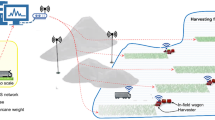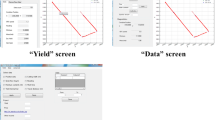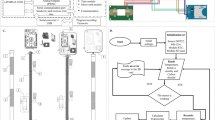Abstract
This study was aimed at accurately estimating total weight of harvested grain on a combine by simply attaching a small yield sensor in the grain tank and by processing the output of the sensor. The yield sensor was first installed in a grain tank of a 1.2 m-swath Japanese-style (head-feeding or jidatsu) combine, and the weight was estimated from individual impulses received at each rotation of a grain-releasing device i.e. an auger blade. A non-linear relation was assumed between the weight of grain released and the impulse received, and the parameters of the non-linear model were optimized to minimize the sum of squares between the estimated and actual weight of grain accumulated at each run of the combine. A threshold for the output discriminated between actual release and no release of the grain from the auger blade. The appropriate range of the threshold was 4–6 times the root-mean squared output of the sensor without throughput (F rms ) of grain. The aim was to enhance the accuracy of the estimation of grain weight by disregarding signals that did not relate to the accumulation of grain in the tank. Two methods of calculating the impulses were proposed after the discrimination: “successive addition” and “interval addition”, and two non-linear models of converting impulses into the weight of grain: “odd function model” and “positive function model”. The use of the odd function model with the impulse calculated by the interval addition was the most robust, and root-mean squared relative errors of calibration and validation were both stable and around 2.5 % at a threshold of 5F rms . In the confirmatory experiment with a larger 1.8 m-swath Japanese-style grain combine equipped with the same sensor, the odd function model with the interval addition achieved root-mean squared relative error of 3.6 % at calibration and 4.4 % at validation at a threshold of 5F rms .





Similar content being viewed by others
References
Arslan, S., & Colvin, T. (2002). Grain yield mapping: Yield sensing, yield reconstruction, and errors. Precision Agriculture, 3(2), 135–154.
Chosa, T., Kobayashi, K., Daikoku, M., Shibata, Y., & Omine, M. (2002). A study on yield monitoring system for head-feeding combines (Part 1): Adoption of an optical sensor and a load cell as a yield monitor. Journal of the Japanese Agricultural Machinery, 64(6), 145–153.
Iida, M., Yao, Y., Nonami, K., Kimura, A., Kaho, T., & Umeda, M. (2004). Impact type grain flow rate sensor for combine. Journal of the Japanese Society of Agricultural Machinery, 66(6), 145–151.
Lee, C. K., Iida, M., Kaho, T., & Umeda, M. (2000). Development of impact type yield sensor for head feeding combine. Journal of the Japanese Agricultural Machinery, 62(4), 81–88.
Microsoft. (2012). About solver. Accessed on August 17, 2012, from http://office.microsoft.com/en-us/excel-help/about-solver-HP005198368.aspx.
Reyns, P., Missotten, B., Ramon, H., & De Baerdemaeker, J. (2002). A review of combine sensors for precision farming. Precision Agriculture, 3(2), 169–182.
Schueller, J. K., Mailander, M. P., & Krutz, G. W. (1985). Combine feedrate sensors. Transactions of the ASAE, 28(1), 2–5.
Shoji, K., Itoh, H., & Kawamura, T. (2009a). A Mini-grain yield sensor compensating for the drift of its own output. Engineering in Agriculture, Environment and Food, 2(2), 44–48.
Shoji, K., Itoh, H., & Kawamura, T. (2009b). In-situ non-linear calibration of grain-yield sensor—Optimization of parameters for flow rate of grain vs. force on the sensor. Engineering in Agriculture, Environment and Food, 2(3), 78–82.
Shoji, K., Kawamura, T., & Horio, H. (2002). Impact-based grain yield sensor with compensation for vibration and drift. Journal of the Japanese Society of Agricultural Machinery, 64(5), 108–115.
Shoji, K., Matsumoto, I., & Kawamura, T. (2011). Impact-by-impact sensing of grain flow on jidatsu combine. Engineering in Agriculture, Environment and Food, 4(1), 1–6.
Taylor, R., Fulton, J., Mullenix, D., Darr, M., McNaull, R., Haag, L., et al. (2011). Using yield monitors to assess on-farm test plots. Paper no. 1110690, ASABE St. Joseph, MI, USA.
Author information
Authors and Affiliations
Corresponding author
Rights and permissions
About this article
Cite this article
Shoji, K., Miyamoto, M. Improving the accuracy of estimating grain weight by discriminating each grain impact on the yield sensor. Precision Agric 15, 31–43 (2014). https://doi.org/10.1007/s11119-013-9327-4
Published:
Issue Date:
DOI: https://doi.org/10.1007/s11119-013-9327-4




